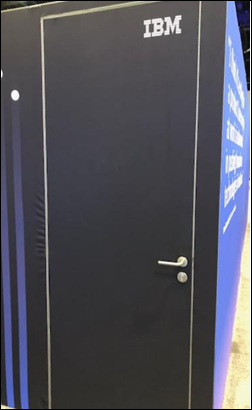"A valid concern..." Oh please. Everyone picks the software they like and the origin of that software is an afterthought.…
From HIMSS 2/14/19
News Items

Veritas Capital is seeking a buyer for the API Healthcare workforce management software business it bought in its July 2018 acquisition of GE Healthcare’s software business. Veritas separated out API Healthcare with the acquisition and restored its previous operating name.

Meanwhile Veritas-owned Virence Health, which merged GE Healthcare’s Centricity business with Athenahealth, confirmed on the HIMSS floor with me today that it will stop using the Virence Health name and instead move forward under the Athenahealth banner. Veritas Capital bought the GE Healthcare assets in July 2018, rebranded the business to Virence Health in October 2018, and then struck a deal to acquire Athenahealth five weeks later. It’s not surprising that the newly formed company couldn’t wait to shed its GE Healthcare albatross with a new name and then found itself owning a far more valuable one in Athenahealth, but a lot of money was wasted rolling out the Virence Health brand for its short run, including printing all those HIMSS19 totes. I told the booth rep that they should sell the trademark since it’s mostly a blank slate at this point anyway.

Adventist Health has laid off all 1,300 employees of Feather River Hospital (CA) and may not reopen the facility that was damaged in the November 2018 Camp Fire. That isn’t much of a reward for those employees whose dedication and heroics saved patients and provided shelter for local residents who were fleeing the devastating wildfire.
From the Burner Phone
“HIMSS sent this registration count for HIMSS19 – 42,595, with 39 percent representing provider organizations.” That’s down a bit from HIMSS18 and well short of the “45,000+” that HIMSS has been touting. Other leading stats for HIMSS19 that would be relevant are exhibitor count (and square footage), percentage of first-time attendees, and percentage of international registrations. My perception is that it was slower than in previous years, less focused given the absence of government mandates, and perhaps an expense that some exhibitors wouldn’t have committed to a year ago if they could have foreseen their now-obvious decrease in business.
“DoD, VA, and CMS take center stage with enormous agency-made booths and session after session talking about how they’re collaborating and leading. Maybe stay home and get your #!@$#!$@# EHR working?! A reminder that their ‘single instance’ has been ‘live’ for two years now and has yet to sniff a D- grade after two major tests. Not suitable, not operable, and most-certainly not INTERoperable.”
Observations
Today featured a beautiful, sunny morning that got even better as it warmed up. The cold and damp from yesterday were quickly forgotten on this last day of HIMSS19. I say “last day” because hardly anyone will stick around for the Friday afternoon wrap-up. This year’s schedule was a mess since the conference started on Tuesday instead of Monday, meaning that all those folks who could have been headed home for Valentine’s Day after the exhibit hall closed for the week on Wednesday now had to wait until this evening, most of them missing what should have been a special day at home.
You may remember the history of why we’re in Orlando this year and again next before returning to Las Vegas for HIMSS21. HIMSS got into a snit with Chicago Tourism in 2014 after finding out that RSNA was given lower hotel room rates and quickly lined up Orlando as a replacement for Chicago for HIMSS19, presumably with less flexibility on dates due to the relatively short notice. HIMSS17 was last in Orlando February 19–23, 2017, with the opening reception on the usual Sunday and the exhibit hall open Monday through Wednesday, a far better and more familiar schedule (I’ve been behind a day every single day this week, including Tuesday, when I was confidently telling everyone it was Monday). Las Vegas will probably always start later in the week because the casinos aren’t about to lose weekend gambling revenue for a conference. HIMSS20 is March 9-13, nearly a full month later than this round (yay – we have a 13-month break), but apparently still on the Tuesday through Friday schedule as this year. Maybe HIMSS has decided to try to synchronize Orlando and Las Vegas in avoiding the Sunday opening reception.
I was quite wrong about how this last day in the exhibit hall played out. I saw few pieces of luggage in booths, companies stuck it out, and reps were reasonably well focused. It was actually a really good day, where booth traffic was down a little and food lines were non-existent. It was quieter and I suspect the quality of the conversations was better. I think some vendors had already written today off and were happy to see fewer swag-seekers and more folks anxious to talk specifics and see demos. Good job not wasting the last day, everyone.
I continue to be amazed at how many men who are employed in healthcare leave the restroom without washing their hands. By the way, you are shaking those same unwashed hands when you visit a booth.
MedData scone trivia – the company brings their own ovens to conventions to bake and then ice the scones, which are made from frozen dough, and it’s all done with their own employees, not convention center catering people. They can do in-booth baking in every convention city except Boston and Las Vegas, where the trade unions are too strong and won’t allow it even if union members man the ovens.
I sat through a dull HIMSS Analytics presentation today, with the only slightly interesting takeaway being that 347 hospitals in 12 countries have achieved EMRAM Stage 7. And that HIMSS is starting yet another adoption model, this one for clinically integrated supply chain like medical devices and implants (H-SIMM). HIMSS sold off its data business to Definitive Healthcare recently, but is keeping the adoption model business, which includes consulting. I haven’t heard why it wanted out of the data business it so desperately wanted in when it bought a data company years ago.

Good job, everyone (including me) who filled a bag with toys and supplies for hospitalized children at the Connection booth. Coincidentally I ran across an old friend today and found that she is CIO at an area facility – she had just learned that kids at her place will be getting a bunch of the bags. It felt good giving and I hope it feels good receiving.
I did get a memory blast from the past from the HIMSS Analytics presentation since the presenter referred to it – old school hospital wiring closets that, when you sent your network tech to reset a router, always required moving the mop and bucket the nurses had stashed there.

Cerner previously never referred to its competitors by name, hoping to diminish them by leaving them anonymous. I was therefore surprised to see two slides from a very long deck playing on a huge monitor at Cerner’s main booth podium, the first of which called out Epic as being late to the interoperability party by not joining CommonWell, the second slamming Meditech with a headline of “Rebranding is not re-engineering” in claiming that Expanse is just a new name for an old product that wasn’t selling. I was surprised that they used the logos of both companies.
I heard from vendors all week that exhibit hall Internet connectivity was too slow to present demos. That’s surprising given what they pay for connectivity.

I wondered if they made the consultants pedal?

I don’t know why I find boxed water amusing, but here it is.

I thought my photo included the name of the vendor that put out this very nice spread at the end of the last exhibit hall day, including some nice chocolate-dipped strawberries. Alas, I did not, but I appreciate whoever it was that sprung for impressive closing-day afternoon treats (the red velvet cookies were great).

Optum made sure that every bench and table were labeled to discourage anyone from sitting on them without permission. They are owned by an insurance company, so they’re good at denials.

I’m not sure what IBM was thinking in buying up the biggest floor space in the exhibit hall, then leaving it largely vacant. Either they over-estimated customer interest or Watson lost its mind trying to recommend a booth size.

I was afraid of this door in the IBM Watson Health booth since I figured it might have been the last thing seen by all those older employees who IBM unceremoniously laid off in its attempt to “correct seniority mix.” Or maybe this is where the “Man Behind the Curtain” is sequestered.

The line to have a custom t-shirt made by DSS stayed long even as the last afternoon of the conference wound down.

A fun giveaway in the form of George Clooney’s tequila Casamigos. Life isn’t fair that someone with George Clooney’s looks and acting career then sells his tequila brand for $1 billion. At least I won one of the little bottles of it.

I wouldn’t want to sit next to a stranger on seats like these.

I admit that while I feel justified in questioning the credentials and intentions of some of the HIMSS Social Media Ambassadors, I’m casting the net too wide because some of them rise above the rest. Case in point is Dr. Nick van Terheyden (you can easily assess my respect because I follow only 133 Twitter accounts and his is one of them). Dr. Nick read that I was shut out from the cool helicopter socks being issued by Intermountain Ventures, and not only did he score me a pair and leave them with Lorre, he also included a pair of pink socks with a beautiful handwritten note that not only describes how he sees the Pink Socks movement, but also his own philosophy. I’m not ashamed to say that it choked me up a little – he was brimming with the positivity that isn’t my long suit. Thank you, Dr. Nick, for sending me not only a giveaway, but a takeaway.

The last view of the convention center from the shuttle bus. Taxis were loading up with people anxious to get to the airport and then home.
I’m too tired to keep working tonight, but this weekend I’ll try to arrive at some kind of conclusions about HIMSS19 and ask you for yours.


I also am continually amazed at how many men don’t wash their hands after using the restroom. Society still struggles to instill kindergarten level skills.
My favorite is when you’re appropriately washing your hands for the twenty + seconds with soap and somebody is standing behind you tut tutting how long you’re taking. Better if they just turn and walk out. We work in a hospital…who knows what bugs are hanging around on the door handles.
I almost feel a little bad and embarrassed for Cerner. It’s notable that MEDITECH’s “re-branded” and “old” EMR has scored higher in KLAS than Cerner’s flagship for the last two years.
And celebrating your first plug & play exchange in the year 2019?! Two brave, pioneering Cerner sites are now connected to the world. Is the $5 billion DoD connected?
RE: Adventist Health & Paradise – your coverage is warranted, but your commentary would have been better off omitted. I know first hand how Adventist Health has worked tirelessly since the disaster contacting each affected associate; understanding their financial, personal and professional needs; providing assistance above and beyond full wages and benefits; finding and offering replacement positions within the system and with other employers. Many employees took new positions, many found employment in nearby towns, some wanted to just keep their full pay and not come back to work, some decided to retire and move, etc. It’s disingenuous to infer that the only “reward” Adventist Health considered for those heroic employees was a pink slip. I think HIMSS has made you tired and cranky…
It’s tough when the hospital won’t reopen for a year or more (if ever — Adventist Health didn’t seem to want to commit to replacing it) and there’s no work for the employees to do and no revenue to pay them from, but it’s a let-down ending for what started out as a feel-good story. Kind of like if US Air had told Sully Sullenberger, “Thanks for saving all those passengers with one of the most amazing displays of piloting talent ever seen, but by the way, the plane was damaged, so we’re letting you go.”
I worked for Cerner at the time of the fire, and Cerner had a few dozen associates at the Feather River facilities. Both Adventist and Cerner’s executive teams contributed out of their own pockets (with matching dollars from their organizations) to create a fund to help the affected employees and their families. From what I recall, the starting point (not necessarily end point) for the assistance was to guarantee 90 days of pay, post fire, and a direct deposit of an unspecified amount of cash to people’s bank accounts to help with their immediate needs. It was clear that Adventist was carefully assessing the needs of the affected personnel, and I think some of the assistance went well beyond that. Cerner’s foundation opened up an additional fundraiser at the companywide level, too.
There was a lot of complexity to the situation. The entire community was burned out, and it wasn’t immediately clear whether there would be a community to serve there in the future if they did rebuild. Many of the affected employees lived locally and had acquired housing that would be difficult to replace (a house valued at $200K in an area where it would cost >$550K to rebuild). Some had good fire insurance. Others didn’t. Many were going to move in search of new housing and jobs. It was a very sad situation, and it didn’t sound like there were easy answers.
Thanks for the detailed guide in the conference and other news as well. After months of public negotiating drama and several lawsuits, Veritas Capital finally managed to close the deal. Two innovative companies with complementary expertise are coming together. Let’s hope we get to see some transformation in the industry.